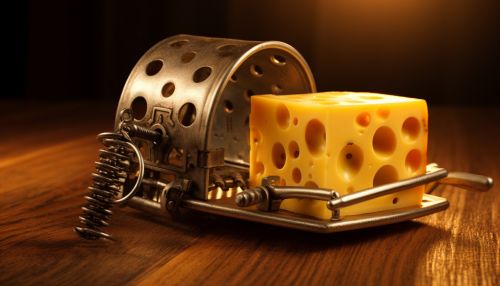Snap traps
Overview
A snap trap is a type of mechanical trapping device primarily used for pest control. The most common form of snap trap is the mousetrap, but variations exist for trapping larger pests such as rats. The trap works by using a spring-loaded mechanism which, when triggered by the pest, snaps shut causing instant death. The trap is usually baited with food to attract the pest. The design of snap traps has evolved over the years, with modern versions being more humane and effective than their predecessors.
History
The first patented snap trap was created by William C. Hooker of Abingdon, Illinois, who received US patent #528671 for his design in 1894. This early design was a significant improvement over previous trapping methods, which often caused prolonged suffering for the trapped animal. The Hooker trap included a spring-loaded bar that would snap shut when the animal stepped on a pressure-sensitive plate, causing instant death. This design became the basis for the modern snap trap.
Design and Mechanism
The basic design of a snap trap includes a heavy-duty spring, a triggering mechanism, and a kill bar. The spring is typically made of metal and is responsible for providing the force that powers the trap. The triggering mechanism is a sensitive plate or tripwire that the pest interacts with, causing the trap to activate. The kill bar is the part of the trap that snaps shut, killing the pest.
When the trap is set, the spring is compressed, storing potential energy. The kill bar is held in place by the triggering mechanism. When a pest steps on the trigger, the stored energy in the spring is released, causing the kill bar to snap shut with considerable force. This action typically kills the pest instantly.
Types of Snap Traps
There are several types of snap traps, each designed for a specific type of pest.
Mousetraps
The most common type of snap trap is the mousetrap. These are small traps designed to catch mice and other small rodents. They are typically baited with cheese, peanut butter, or other food items that mice find attractive.
Rat Traps
Rat traps are larger versions of the mousetrap, designed to catch rats and other larger rodents. They function in the same way as mousetraps but are larger and stronger to deal with the size and strength of rats.
Other Types
There are also specialized snap traps for other pests, such as squirrels, gophers, and moles. These traps are often designed to be placed in the burrows or nests of these animals.
Usage and Effectiveness
Snap traps are widely used for pest control in homes, farms, and commercial establishments. They are considered one of the most effective methods of pest control, as they kill pests instantly and do not rely on poisons, which can be harmful to pets and humans.
However, the effectiveness of snap traps can be influenced by several factors. These include the type and amount of bait used, the placement of the trap, and the type of pest being targeted. For example, some pests may be wary of new objects in their environment and may avoid a newly placed trap.
Ethical Considerations
While snap traps are generally considered humane as they kill pests instantly, some animal rights groups argue that the use of such traps is cruel. They advocate for the use of live traps, which capture pests without harming them, allowing for their release in a different location.
However, others argue that live traps are not always a practical or humane solution, as released pests may not survive in their new environment or may simply return to the area from which they were removed.
See Also


